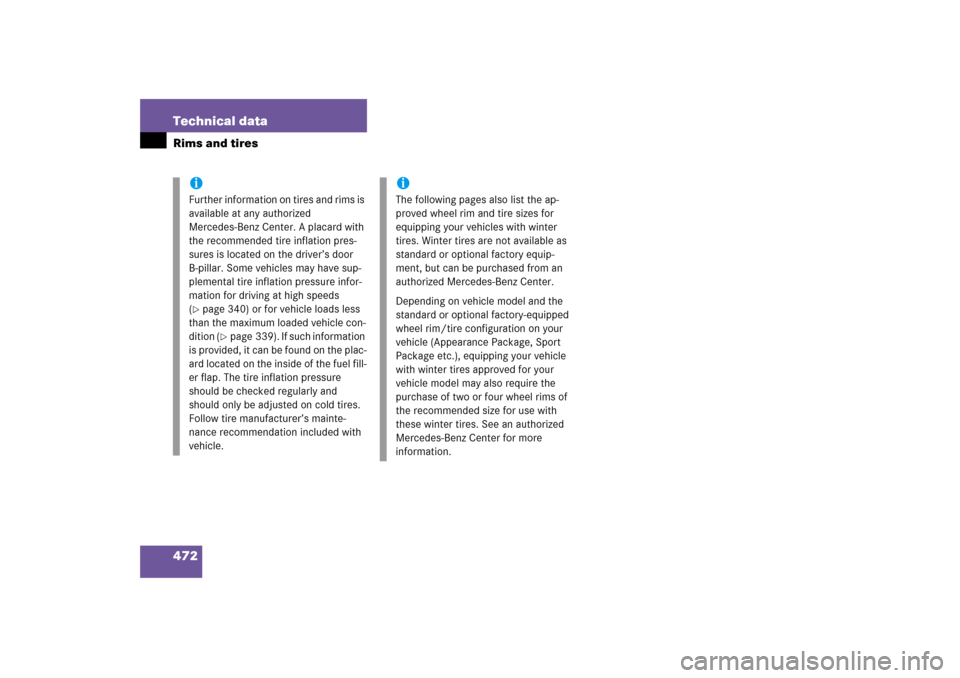Page 472 of 514

471 Technical data
Rims and tires
�Rims and tires
!
Only use tires which have been tested
and approved by Mercedes-Benz. Tires
approved by Mercedes-Benz are devel-
oped to provide best possible perfor-
mance in conjunction with the driving
safety systems on your vehicle such as
ABS or ESP
®. Tires specially developed
for your vehicle and tested and ap-
proved by Mercedes-Benz can be iden-
tified by finding the following on the
tire’s sidewall:
�
MO = M
ercedes-Benz O
riginal
equipment tires
AMG vehicles:
Does not apply to all approved tires
on AMG vehicles. For information
on tested and approved tires for
AMG vehicles, contact an autho-
rized Mercedes-Benz Center.
�
MOE = M
ercedes-Benz O
riginal
E
xtended (tires with limited run-flat
characteristics) original equipment
tires
Using tires other than those approved
by Mercedes-Benz may result in dam-
age that is not covered by the
Mercedes-Benz Limited Warranty.iFor information on driving with
MOExtended tires, see
“MOExtendedsystem*” (
�page 345).
!Using tires other than those approved
by Mercedes-Benz can have detrimen-
tal effects, such as�
poor handling characteristics
�
increased noise
�
increased fuel consumption
Moreover, tires and rims not approved
by Mercedes-Benz may, under load,
exhibit dimensional variations and dif-
ferent tire deformation characteristics
that could cause them to come into
contact with the vehicle body or axle
parts. Damage to the tires or the vehi-
cle may be the result.
Page 473 of 514

472 Technical dataRims and tires
iFurther information on tires and rims is
available at any authorized
Mercedes-Benz Center. A placard with
the recommended tire inflation pres-
sures is located on the driver’s door
B-pillar. Some vehicles may have sup-
plemental tire inflation pressure infor-
mation for driving at high speeds
(�page 340) or for vehicle loads less
than the maximum loaded vehicle con-
dition (
�page 339). If such information
is provided, it can be found on the plac-
ard located on the inside of the fuel fill-
er flap. The tire inflation pressure
should be checked regularly and
should only be adjusted on cold tires.
Follow tire manufacturer’s mainte-
nance recommendation included with
vehicle.
iThe following pages also list the ap-
proved wheel rim and tire sizes for
equipping your vehicles with winter
tires. Winter tires are not available as
standard or optional factory equip-
ment, but can be purchased from an
authorized Mercedes-Benz Center.
Depending on vehicle model and the
standard or optional factory-equipped
wheel rim/tire configuration on your
vehicle (Appearance Package, Sport
Package etc.), equipping your vehicle
with winter tires approved for your
vehicle model may also require the
purchase of two or four wheel rims of
the recommended size for use with
these winter tires. See an authorized
Mercedes-Benz Center for more
information.
Page 474 of 514
473 Technical data
Rims and tires
Same size tires
CLK 350
CLK 500
Rims (light alloy)
7.5 J x 17 H2
7.5 J x 17 H2
Wheel offset
1.42 in (36 mm)
1.45 in (37 mm)
Winter tires
1,3
1Radial-ply tires
225/45 R17 91 H M+S.
225/45 R17 91 H M+S.
Winter tires
1,2,3
2Must be used in conjunction with Run Flat Indicator* only. 3Not available as factory equipment.
225/45 R17 91 H M+S.MOExtended
225/45 R17 91 H M+S.MOExtended
Page 476 of 514
475 Technical data
Rims and tires
Mixed size tires
CLK 350
CLK 500
CLK 55 AMG
Front axle:
Rims (light alloy)
7.5 J x 17 H2
7.5 J x 17 H2
7.5 J x 18 H2
Wheel offset
1.42 in (36 mm)
1.46 in (37 mm)
1.46 in (37 mm)
Summer tires
1
1Radial-ply tires
225/45 R17 91W
225/45 R17 91W
225/40 ZR18 92Y XL (Extra Load)
Summer tires
*1,2
2Must be used in conjunction with Run Flat Indicator* only.
225/45 R17 91W MOExtended
225/45 R17 91W MOExtended
-
Rear axle:
Rims (light alloy)
8.5 J x17 H2
8.5 J x17 H2
8.5 J x18 H2
Wheel offset
1.18 in (30 mm)
1.18 in (30 mm)
1.18 in (30 mm)
Summer tires
1,3
3Must not be used with snow chains.
245/40 R17 91W
245/40 ZR17 91W
255/35 ZR18 94Y XL (Extra Load)
Summer tires
*1,2,3
245/40 R17 91W MOExtended
245/40 R17 91W MOExtended
-
Page 477 of 514
476 Technical dataRims and tiresMinispare wheel
All Models
Rim
3.5 B x 17 H2
Wheel offset
0.67 in (17 mm)
Tire
1
1Must not be used with snow chains.
T 125/80 R 17 99M
!Please compare the recommended tire
inflation pressure for your vehicle with
the tire inflation pressure on the yellow
label located on the spare wheel rim.
If the tire inflation pressure on the yel-
low label on the spare wheel rim differs
from the values given in this Operator’s
Manual, inflate the spare wheel tire to
the recommended tire inflation pres-
sure given on the yellow label on the
spare wheel rim.
iPlease note that the tire inflation pres-
sure of the Minispare tire differs from
the tire inflation pressure of the road
tires.
Make sure the Minispare tire is inflated
to approximately 60 psi (4.1 bar).
Page 488 of 514

487 Technical terms
ABS
(A
ntilock B
rake S
ystem)
Prevents the wheels from locking up
during braking so that the vehicle can
continue to be steered.
Accessory weight
(
�page 355)
Air pressure
(�page 355)
Alignment bolt
Metal pin with thread. The centering
pin is an aid used when changing a tire
to align the wheel with the wheel hub.
Aspect ratio
(�page 355)
Bar
(�page 355)
BAS
(Brake A
ssist S
ystem)
System for potentially reducing braking
distances in emergency braking situa-
tions. The system is activated when it
senses an emergency based on how
fast the brake is applied.Bead
(
�page 355)
Bi-Xenon headlamps*
Headlamps which use an electric arc as
the light source and produce a more in-
tense light than filament headlamps.
Bi-Xenon headlamps produce low
beam and high beam.
CAC
(Customer A
ssistance C
enter)
Mercedes-Benz customer service cen-
ter, which can help you with any ques-
tions about your vehicle and provide
assistance in the event of a break-
down.
CAN system
(C
ontroller A
rea N
etwork)
Data bus network serving to control ve-
hicle functions such as door locking or
windshield wiping.Cockpit
All instruments, switches, buttons and
indicator/warning lamps in the passen-
ger compartment needed for vehicle
operation and monitoring.
Cold tire inflation pressure
(
�page 355)
COMAND
(Cockpit M
anagement and D
ata Sys-
tem)
Information and operating center for
vehicle sound and communications
systems, including the radio and the
navigation system, as well as other op-
tional equipment (CD changer*, tele-
phone, etc.).
Control system
The control system is used to call up
vehicle information and to change
component settings. Information and
messages appear in the multifunction
display. The driver uses the buttons on
the multifunction steering wheel to
navigate through the system and to ad-
just settings.
Page 490 of 514

489 Technical terms
Head-thorax air bag
Installed in the driver and the front pas-
senger seat, these air bags protect oc-
cupants during side impact collisions
exceeding a preset threshold. Unlike
normal side impact air bags,
head-thorax air bags are also designed
to provide protection for the head area.
Instrument cluster
The displays and indicator/warning
lamps in the driver’s field of vision, in-
cluding the tachometer, speedometer,
coolant temperature indicator and fuel
display.
KEYLESS-GO*
System for entering and operating the
vehicle without the use of a SmartKey.
Kickdown
Depressing the accelerator past the
point of resistance shifts the transmis-
sion down to the lowest possible gear.
This very quickly accelerates the vehi-
cle and should not be used for normal
acceleration needs.Kilopascal (kPa)
(
�page 356)
Locking knob
Knob on the door which indicates
whether the door is locked or un-
locked. Pushing the locking knob down
on the driver’s or passenger door from
inside will lock that door.
Maintenance System (U.S. vehicles)
Maintenance service indicator in the
multifunction display that informs the
driver when the next vehicle mainte-
nance service is due. The Maintenance
System in your vehicle tracks distance
driven and the time elapsed since your
last maintenance service, and calls for
the next maintenance service
accordingly.
Maximum load rating
(�page 356)
Maximum loaded vehicle weight
(�page 356)Maximum tire inflation pressure
(
�page 356)
Memory function*
Used to store three individual seat,
steering wheel and exterior mirror
positions.
Menu
The control system displays are ar-
ranged in menus. Each menu contains
a number of commands for particular
systems.
MON
(Motor O
ctane N
umber)
The Motor Octane Number for gasoline
as determined by a standardized meth-
od. It is an indication of a gasoline's
ability to resist undesired detonation
(knocking). The average of both the
MON (Motor Octane Number) and
->RON (Research Octane Number) is
posted at the pump, also known as
ANTI-KNOCK INDEX.
Page 491 of 514

490 Technical termsMOE
(M
ercedes-Benz O
riginal E
xtended
equipment tires)
Tires with limited run-flat characteris-
tics. The MOExtended system allows
you to continue driving your vehicle
even if there is a total loss of pressure
in one or more tires.
Multifunction display
Display field in the speedometer used
to present information provided by the
control system.
Multifunction steering wheel
Steering wheel with buttons for operat-
ing the control system.
Normal occupant weight
(
�page 356)
OCS
(Occupant C
lassification S
ystem)
The system automatically turns the
front passenger front air bag on or off
based on the classified occupant size
category determined by weight sensor
readings from the seat.Overspeed range
Engine speeds within the red marking
on the tachometer dial. Avoid this en-
gine speed range, as it may result in se-
rious engine damage that is not
covered by the Mercedes-Benz Limited
Warranty.
Poly-V-belt drive
Drives engine-components (alternator,
AC compressor, etc.) from the engine.
Power train
Collective term designating all
components used to generate and
transmit motive power to the drive
axles, including
�
engine
�
clutch/torque converter
�
transmission
�
transfer case
�
drive shaft
�
differential
�
axle shafts/axlesProduction options weight
(
�page 356)
Program mode selector switch
Used to switch the automatic transmis-
sion between regular operationS and
comfort operationC.
CLK 55 AMG with steering wheel gear-
shift control and manual shift program:
In addition toS andC (for regularS or
comfortC operation, see above) you
can use theM for manual shift
program.
PSI
(Pounds per S
quare I
nch)
(
�page 356)
Recommended tire inflation pressure
(�page 356)
REST*
(Residual engine heat utilization)
Feature that uses the engine heat
stored in the coolant to heat the vehi-
cle interior for a short time after the en-
gine has been turned off.